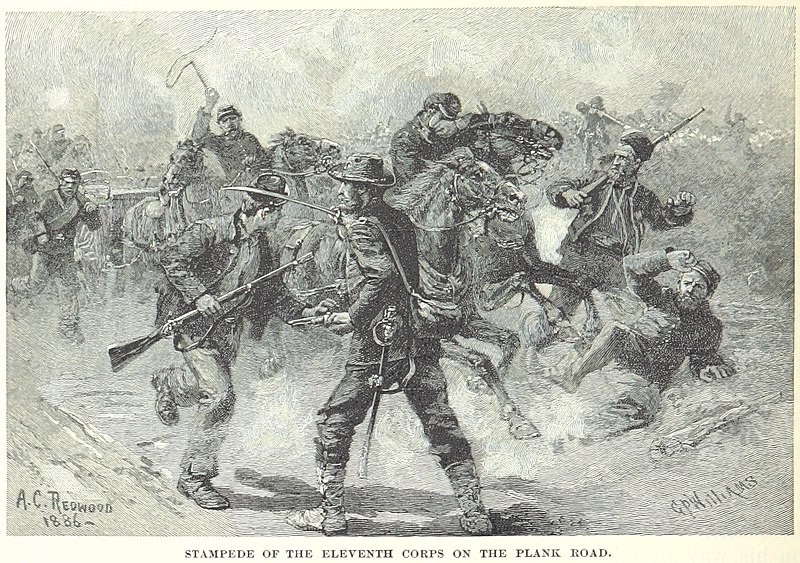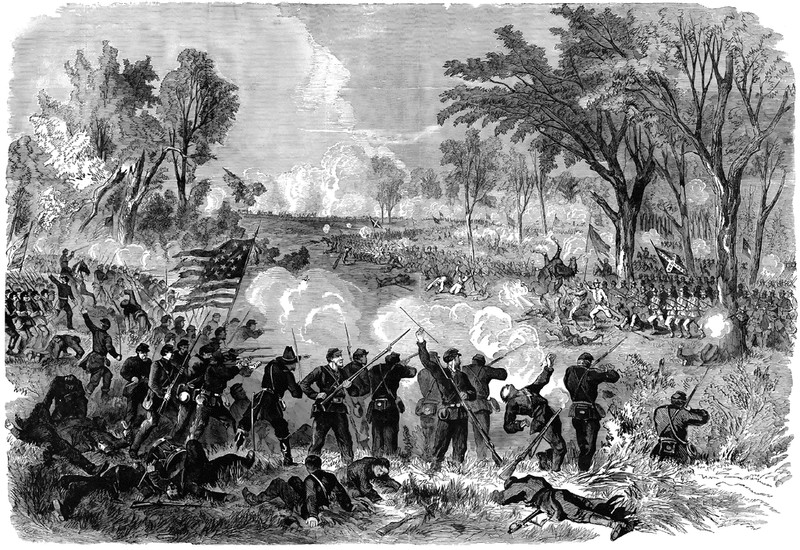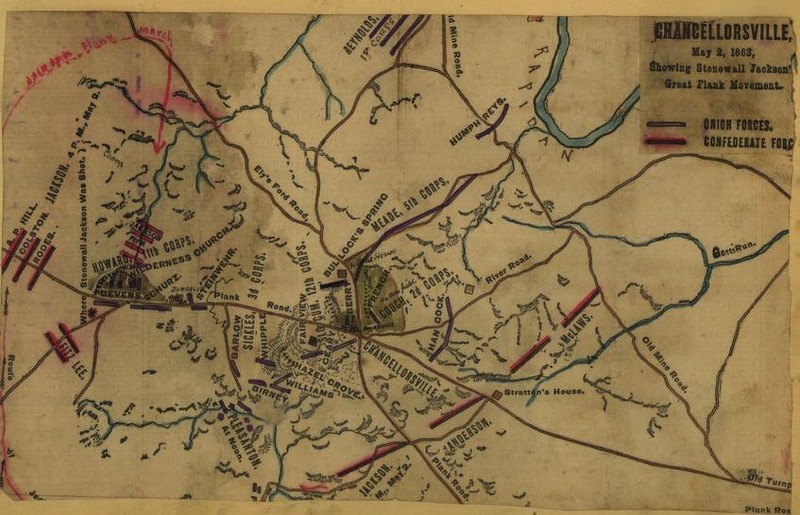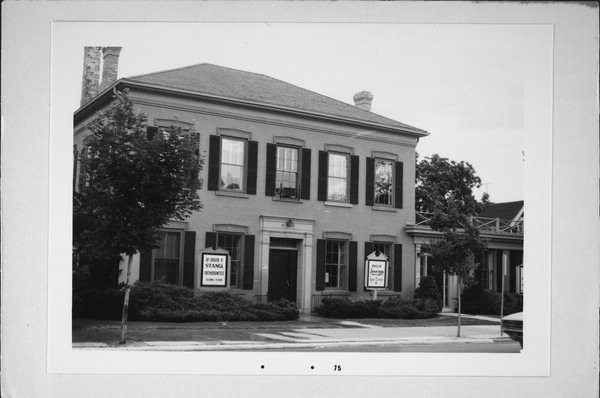John Grundke Residence
Introduction
Text-to-speech Audio
John Grundke is another Civil War veteran that lived here in Cedarburg. Just like are our four previous Civil War related connections to Cedarburg, Grundke's was different however. He only fought in one battle. But it would be a battle that affected the rest of his life as well as his involvement here in Cedarburg.
Images
This Lithograph Depicts Soldiers Of The XI Corps retreating from the Confederate attack at Chancellorsville. Regiments such as the 26th Wisconsin and the 45th New York fought fiercely and held their ground. Lithographs would advance the myth of the fleeing XI Corps soldier until the twenty-first century.

This Litograph Shows The Stand Of A Union Regiment At Chancellorsville. The 26th Wisconsin and the 45th New York were like this reigment.

Battlefield Map Of Chancellorsville. To The Left You Can See Where Jacob Grundke, the 26th Wisconsin, and the XI Corps were positioned.

The Grundke Residence.

Backstory and Context
Text-to-speech Audio
On the other hand, this building contained famous Cedarburger William Schroeder for the time being. Established in 1853, Schroeder had a son-in-law named John Grundke, that married into the Schroeder family. Because of the notable name of William Schroder, his influence in the community, and his many business ventures in establishing Cedarburg. His son-in-law would use the economic influence that he inherited from his father-in-law and would later make the residence much more prominent; as a result, Grundke would also convert the residence into a two-story Georgian-style design that was very impressive continues to be influential today. While making the residence much fancier, Grundke also decided to case the walls here with brick and raise the second-story roof of the building on the residence's original roof beams. The southern addition of the building would be built in 1965 for a business that wanted office space.
John Grundke also served in the Civil War with the 26th Wisconsin Volunteer Infantry. He enlisted in August of 1862, but his residence was in Wauwatosa before living in Cedarburg. When the 26th was formed and trained in Milwaukee, the regiment would then be transferred to Washington D.C. in October of 1862, where it was assigned, as described earlier, to William Nero and his relation with the regiment. Henry Roth, whose residence we described earlier and his Civil War service, also ties into what John Grundke would experience in his Civil War service. The 26th Wisconsin would be assigned to the Union Army (United States) XI Corps. Before we move on, I want to describe how a United States army corps was organized during the Civil War. You start with the soldier; then, you have a platoon, a group of soldiers. Then once that platoon gets more extensive, you have a company with company officers. When it becomes a larger company, that is called a regiment. Suppose it is more than one regiment, then it's a brigade; if it's more than three regiments, it's a division. Then once these divisions are organized, they are called a Corps, and artillery units are organized the same way.
The 26th Wisconsin would be assigned to the 2nd Brigade, 3rd division, of the XI Corps and were assigned with the Union (United States) Army Of The Potomac. Due to the hostility towards immigrants, Grundke and other German immigrants and German-Americans like him were demonized and ridiculed; many Americans thought they wouldn't make good soldiers. This is partially true due to another battle that the 26th fought in was the Battle of Chancellorsville, Virginia, in May of 1863. The 26th and the XI Corps would march with the army to Chancellorsville and set up camp at an area near a road called the Orange Plank Road near a woods called, The Wilderness. On May 2nd, 1863, despite many warnings from soldiers of the XI Corps of Confederate movements to attack their open flank, Union commanders thought they were retreating. As a result, soldiers built defensive perimeters, fence lines, and earthworks to be prepared for the attack that was to come. At sunset on May 2nd, Confederates under the command of Thomas "Stonewall" Jackson attacked the XI Corps positions. Some soldiers, shocked at this, ran away.
But not every soldier ran away. The 26th Wisconsin and other regiments in their division and others held their position and inflicted heavy casualties upon the Confederate attackers. Other regiments like the 26th as the 45th New York would also fight fiercely but at the same time suffered heavy casualties. John Grundke, who was Sargent at the time, would be one of those casualties; he would be wounded very severely. A severe wound at this time would result in amputation; this likely is what happened to him. Grundke would be discharged on disability in April of 1864. After the fighting at Chancellorsville, the XI Corps would be reviled and demonized as cowards by their fellow Americans and their fellow soldiers; myths over the years portrayed the XI Corps at Chancellorsville as fleeing without even firing a shot. This, of course, due to heavy research of regimental actions and artillery batteries, shows these myths to be untrue.
But when looking at the Confederate attack, the Confederates, under the command of Robert E. Lee, suffered a higher casualty percentage than the Union Army. The Confederates suffered 22% casualties out of 60,000, while the Union only had 17% casualties. He could not replace his men; this was because of the heavy fighting by the 26th Wisconsin, the 45th New York, and other fighting regiments and batteries in the XI Corps. They would later fight fiercely at Gettysburg and, as a result, restored their name to a tough fighting corp. For Grundke, Chancellorsville was his only battle, and he came home and eventually moved to Cedarburg after the war. Grundke would also be involved with running the Cedarburg grist mill that Schroeder and other managers were operating.
But again, as mentioned before with Henry Roth, William Nero, and Jacob Grundke, they were never the same when they came home after the war. Gurndke, along with Roth and Nero, may have suffered from PTSD, tough readjustment to civilian life, getting pensions from the government for coverage, and dealing and wrestling with the meaning of their physical and mental wounds affected them the rest of their lives. Grundke's story is like other Civil War veterans that lived here in Cedarburg. We have to remember that these men were human beings behind the buildings and the facade. They impacted Cedarburg and many other communities in the United States. Still, they also went through the horrors and suffering of war that ultimately taught them the value of community and purpose.
Sources
Paula, James S.. Under The Crescent Moon: With The XI Corps In The Civil War/From The Defenses Of Washington To Chancellorsville, 1862-1863. Volume 1. El Dorado Hills, California. Savas Beatie, 2017.
Pula, James S.. The Siegel Regiment: A History Of The 26th Wisconsin Volunteer Infantry, 1862-1865. Campbell, California. Savas Publishing Company, 1998.
Zimmermann, H. Russell. The Heritage Guidebook: Landmarks And Historic Sites In Southeastern Wisconsin. Milwaukee, Wisconsin. Heritage Banks, 1976. 193.
Zimmermann, H. Russell. The Heritage Guidebook: Landmarks And Historic Sites In Southeastern Wisconsin/Highlights Of Historic Cedarburg. Milwaukee, Wisconsin. Heritage Banks, 1976.
A Walk Through Yesterday: In Cedarburg Wisconsin. 2005.
Chancellorsville, American Battlefield Trust. Accessed May 26th 2022. https://www.battlefields.org/learn/civil-war/battles/chancellorsville.
Sears, Stephen W.. Chancellorsville. New York, New York. Houghton Mifflin Company, 1996.
https://content.wisconsinhistory.org/digital/collection/tp/id/36248. Roster Of Wisconsin Volunteers, War Of The Rebellion, 1861-1865, Volume II.
Quiner, E.B.. Military History Of Wisconsin. Chicago, Illinois. Clarke & Company, 1866. 746-749.
https://commons.wikimedia.org/wiki/File:Stampede_of_the_XI_Corps.jpg
https://etc.usf.edu/clipart/11600/11680/chancellors_11680.htm
Sneden, Robert Knox. Chancellorsville, May 2, showing Stonewall Jackson's great flank movement. [to 1865, 1863] Map. https://www.loc.gov/item/gvhs01.vhs00287/.
https://www.wisconsinhistory.org/Records/Property/HI13369
